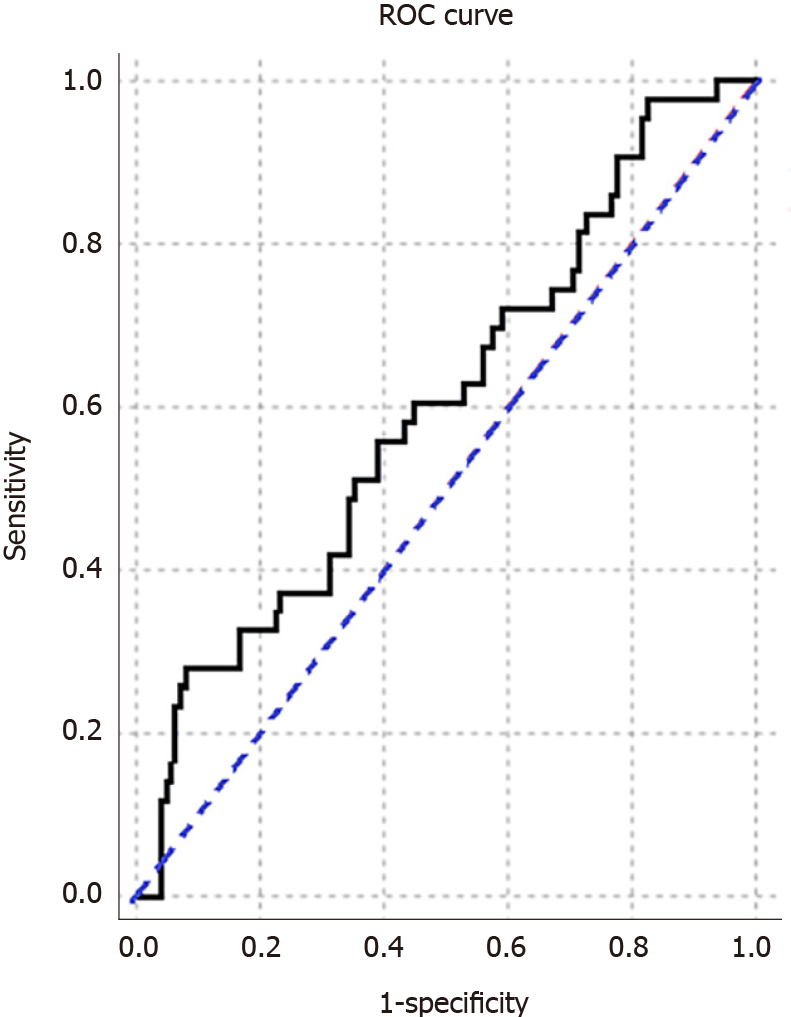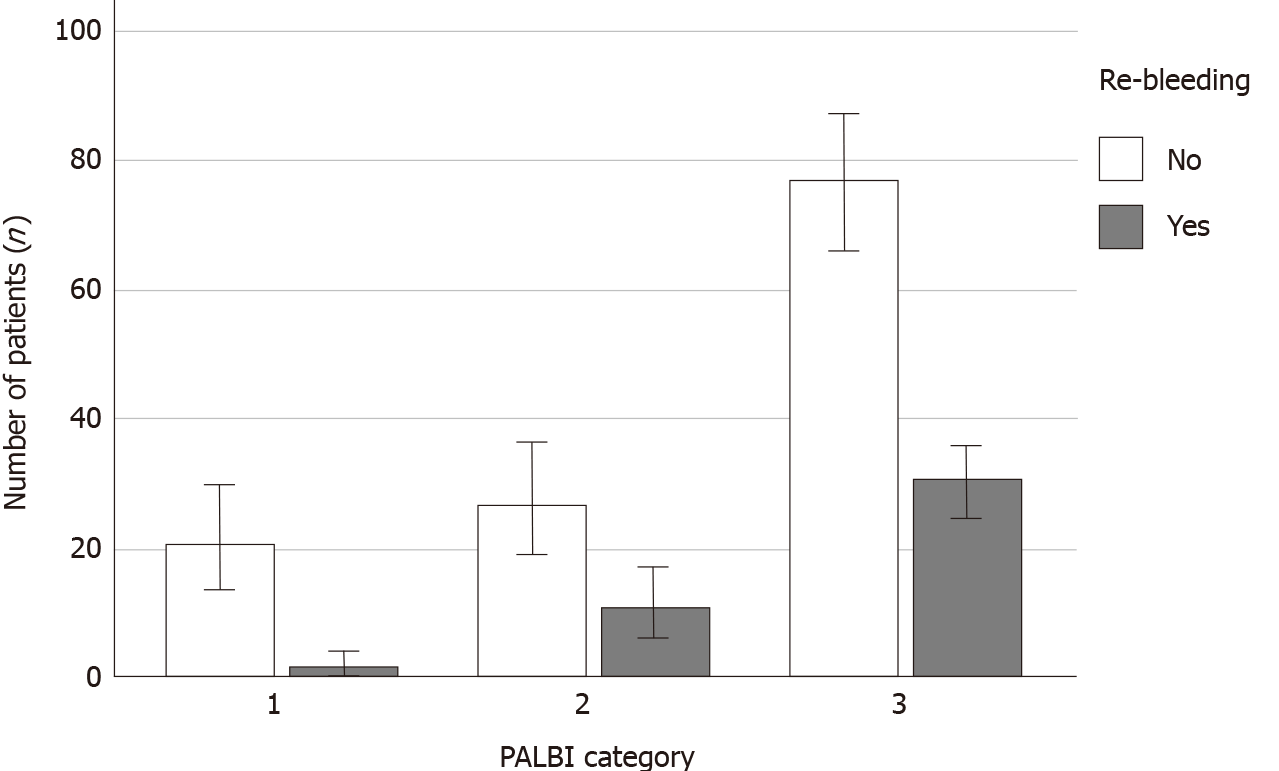Published online Oct 27, 2020. doi: 10.4254/wjh.v12.i10.880
Peer-review started: July 2, 2020
First decision: July 30, 2020
Revised: September 17, 2020
Accepted: September 25, 2020
Article in press: September 25, 2020
Published online: October 27, 2020
Processing time: 113 Days and 22.5 Hours
Platelet-albumin-bilirubin (PALBI) score was proposed by Roayaie et al with modification of previously studied albumin-bilirubin score to include platelet as an indicator of portal hypertension in 2015. Predictive value of this score was recently tested by Elshaarawy et al for re-bleeding in patients presenting with acute variceal hemorrhage. We did a similar study at our center (n = 170) to look at incidence of re-bleeding after band ligation defined as drop in 2 units of hemoglobin and witnessed melena or hematemesis within 2 wk of the procedure. We calculated PALBI scores for all patients based on lab values prior to the procedure. Of 25.3% had re-bleeding episodes, area under receiver operating characteristic curve for PALBI as predictor of re-bleeding was 0.601 (95% confidence interval: 0.502-0.699). PALBI score showed moderate accuracy at predicting re-bleeding in our population.
Core Tip: Platelet-albumin-bilirubin score showed moderate accuracy in predicting re-bleeding after band ligation in patients presenting with acute variceal hemorrhage.
- Citation: Faisal MS, Singh T, Amin H, Modaresi Esfeh J. Role of platelet-albumin-bilirubin score in predicting re-bleeding after band ligation for acute variceal hemorrhage. World J Hepatol 2020; 12(10): 880-882
- URL: https://www.wjgnet.com/1948-5182/full/v12/i10/880.htm
- DOI: https://dx.doi.org/10.4254/wjh.v12.i10.880
We read with great interest article by Elshaarawy et al[1] regarding the role of platelet-albumin-bilirubin (PALBI) score in predicting re-bleeding and in-patient mortality for patients presenting with acute variceal hemorrhage[1]. The authors found that area under receiver operating characteristic (AUROC) for PALBI with outcome of re-bleeding was 0.794. This was higher than Child-Turcot-Pugh (CTP), Model of End Stage Liver Disease and Albumin-Bilirubin (ALBI) scores, which were 0.681, 0.74 and 0.766, respectively. PALBI score was proposed by Roayaie et al[2] with modification of previously proposed ALBI score to include platelet as an indicator of portal hypertension in 2015[2]. It has been studied as a predictor of liver transplant outcomes[3], rate of decompensation in compensated cirrhosis[4], outcomes of locoregional treatment for liver cancer[5] and now for re-bleeding after acute variceal hemorrhage.
We did a similar study at our center and calculated the PALBI score to validate this data. Our study comprised of 170 patients with a diagnosis of cirrhosis who presented with acute variceal hemorrhage and underwent esophageal variceal band ligation from 2017 to 2018. Of our patients, 18.8% were CTP-A, 48.2% CTP-B and 32.9% CTP-C. In comparison, Elshaarawy et al[1] had 4.5% CTP-A, 29.2% CTP-B and 66.8% CTP-C patients. Our outcome of interest was re-bleeding with the definition proposed by Baveno VI: Drop in two units of hemoglobin along with hematemesis or melena observed clinically within 2 wk of the procedure. 25.3% had re-bleeding in our population based on this definition. 12.1%, 22.6% and 64.3% of our patients qualified for PALBI category 1 (score ≤ -2.53), 2 (score > -2.53 and ≤ -2.09) and 3 (score >-2.09) respectively.
AUROC for PALBI score in predicting re-bleeding was calculated to be 0.601 (95% confidence interval: 0.502-0.699) and the curve is shown in Figure 1. This indicates moderate quality at best of the PALBI score in predicting re-bleeding after band ligation. This is lower than the reported AUROC by Elshaarawy et al[1] by 24.3%. 4.5% of re-bleeders in our cohort belonged to PALBI category 1, 28.9% to PALBI category 2 and 28.7% to PALBI category 3. Rates of re-bleeding in each category are shown in Figure 2.
We found PALBI score to be relatively less accurate than reported by Elshaarawy et al[1] in predicting re-bleeding after band ligation. This discrepancy can be due to differences in the size and characteristics of patient population and definition of the outcome. We only included patients who underwent band ligation for acute variceal hemorrhage from esophageal varices. In contrast, only 51.7% of Elshaarawy et al[1] underwent band ligation alone as treatment for variceal hemorrhage. Their outcome of interest was re-bleeding within 5 d, but we evaluated for re-bleeding within 2 wk following the procedure. Both studies were limited by retrospective design, small number of patients and data from a single institution.
In conclusion, PALBI score is a promising tool for predicting re-bleeding after initial presentation with acute variceal hemorrhage. More data is needed to validate its use in clinical settings post band ligation procedure.
Manuscript source: Unsolicited manuscript
Specialty type: Gastroenterology and hepatology
Country/Territory of origin: United States
Peer-review report’s scientific quality classification
Grade A (Excellent): 0
Grade B (Very good): 0
Grade C (Good): C
Grade D (Fair): 0
Grade E (Poor): 0
P-Reviewer: Garbuzenko DV S-Editor: Liu M L-Editor: A P-Editor: Li X
| 1. | Elshaarawy O, Allam N, Abdelsameea E, Gomaa A, Waked I. Platelet-albumin-bilirubin score - a predictor of outcome of acute variceal bleeding in patients with cirrhosis. World J Hepatol. 2020;12:99-107. [RCA] [PubMed] [DOI] [Full Text] [Full Text (PDF)] [Cited by in Crossref: 13] [Cited by in RCA: 19] [Article Influence: 3.8] [Reference Citation Analysis (3)] |
| 2. | Poster Sessions. Hepatology. 2015;62 Suppl 1:93A-207A. [RCA] [PubMed] [DOI] [Full Text] [Cited by in Crossref: 5] [Cited by in RCA: 5] [Article Influence: 0.5] [Reference Citation Analysis (0)] |
| 3. | Chedid MF, Picon RV, Chedid AD. ALBI and PALBI: Novel Scores for Outcome Prediction of Cirrhotic Outpatients Awaiting Liver Transplantation. Ann Hepatol. 2018;17:906-907. [RCA] [PubMed] [DOI] [Full Text] [Cited by in Crossref: 8] [Cited by in RCA: 11] [Article Influence: 1.6] [Reference Citation Analysis (0)] |
| 4. | Oikonomou T, Goulis L, Doumtsis P, Tzoumari T, Akriviadis E, Cholongitas E. ALBI and PALBI Grades Are Associated with the Outcome of Patients with Stable Decompensated Cirrhosis. Ann Hepatol. 2019;18:126-136. [RCA] [PubMed] [DOI] [Full Text] [Cited by in Crossref: 28] [Cited by in RCA: 37] [Article Influence: 6.2] [Reference Citation Analysis (1)] |
| 5. | Ho CHM, Chiang CL, Lee FAS, Choi HCW, Chan JCH, Yeung CSY, Huang JJ, Chan MKH, Blanck O, Wong FCS. Comparison of platelet-albumin-bilirubin (PALBI), albumin-bilirubin (ALBI), and child-pugh (CP) score for predicting of survival in advanced hcc patients receiving radiotherapy (RT). Oncotarget. 2018;9:28818-28829. [RCA] [PubMed] [DOI] [Full Text] [Full Text (PDF)] [Cited by in Crossref: 16] [Cited by in RCA: 28] [Article Influence: 4.0] [Reference Citation Analysis (0)] |














